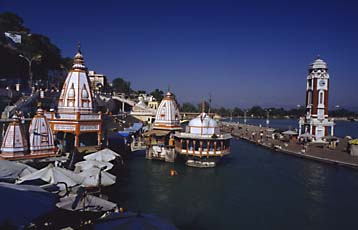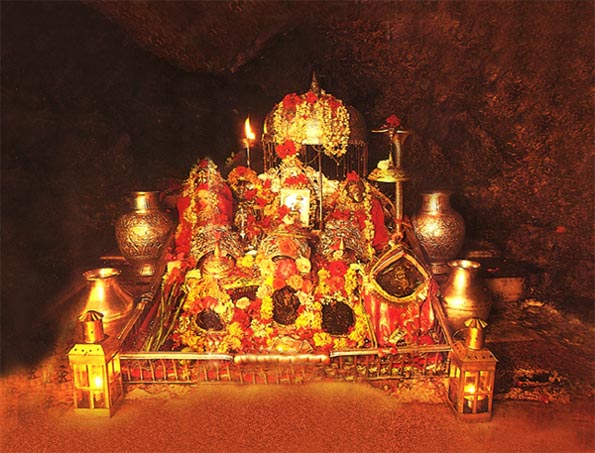|
KEDARNATH TEMPLE-[UTTAR PRADESH-INDIA]  The Kedarnath shrine, one of the 12 jyotirlingas of Lord Shiva, is a scenic spot situated, against the backdrop of the majestic Kedarnath range. At an altitude of 3,581 mt it is a 14 km trek from Gaurikund.
Kedar is another name of Lord Shiva, the protector and the destroyer. Shiva is considered the embodiment of all passions love, hatred, fear death and mysticism which are expressed through his various forms.
There are more than 200 shrines dedicated to Lord Shiva in Chamoli district itself, the most important one is Kedarnath. According to legend, the Pandavas after having won over the Kauravas in the Kurukshetra war, felt guilty of having killed their own brothers and sought the blessings of Lord Shiva for redemption. He eluded them repeatedly and while fleeing took refuge at Kedarnath in the form of a bull.
On being followed he dived into the ground, leaving his hump on the surface. The remaining portions of Lord Shiva appeared at four other places and are worshipped there as his manifestations.
The arms appeared at Tungnath, the face at Rudranath, the belly at Madmaheshwar and his locks (hair) and the four above mentioned shrines are treated as Panch Kedar.
BADRINATH-[UTTAR PRADESH- INDIA] Badrinath is one of the Four Dhams of the country and is situated at an elevation of 3,133 meters above sea level, guarded on either side by the two mountain ranges knows as NAR & NARAYAN with the towering Neelkanth Peak providing a splendid back - drop. This revered spot was once carpeted with wild berries which gave it the name Badri Van, meaning forest of berries. Facing the temple at the bank of Alaknanda river there is a hot water spring known as TAPT KUND. A bath in this spring is refreshing to all travelers. And for women a separate tank is available. The temple opens every year in the month of May and closes for winters in the third week of November. The places to be visited around it are Charan Paduka (2 kms.), Mana village (4 kms.) Vyas Gufa, Shesh Netra Tal and Ganesh Gufa, Bhimpul (4 kms.), Mata Moorty, Vasudhara Falls (8 kms.). GANGOTRI TEMPLE-[UTTAR PRADESH-INDIA] Gangotri is one of the Char dhams of Uttarakhand. It is situated in the magnificent Garhwal Himalayas at an elevation of 3048 meters and is 105 kms from Uttarkashi. The Gangotri shrine is seen as the spiritual source of Hinduism's most sacred river, the Ganga. According to Hindu mythology, Ganga, the stream ofl life, was granted as reward for king Bhagiraths severe penance, and the rivers worshipped as a deity. Gaumukh, 18kmsouthwest of Gangotri, along the Gangotri glacier. The temple at Gangotri, which is visited by thousands of pilgrims between May and November, was built by a Gorkha Commander Amar Singh Thappa in the early 18th century.
YAMNOTRI TEMPLE-[UTTAR PRADESH-INDIA] Yamunotri forms the source of the river Yamuna in the Bandarpunch Mountain, which is 6315 metres above the sea level. It is one of the four most significant pilgrimage places collectively called Char Dham in the Garhwal Himalayas. A temple has been constructed here dedicated to Goddess Yamuna and the holy thermal springs. This temple forms a major attraction for thousands of tourists every year. HARIDWAR-[UTTAR PRADESH-INDIA]  Bhagiratha brought the Ganges into the earth, and into this point where his ancestors were burnt to ashes by the curse of the sage Kapila. Kapilastaan, a spot in Haridwar is pointed to as Kapila's hermitage. Haridwar was once known as Gangadwara.
Haridwar (and Rishikesh) represents the gateway to the Himalayan pilgrimage shrines of Badrinath and Kedarnath. The pilgrimage to the Himalayan shrines begins only when the sun reaches the zodiac sign of Aries. Haridwar is also the site of celebration of the Kumbha Mela, once in twelve years, when Jupiter transits to the zodiac sign of Aquarius.
The five sacred bathing spots in Haridwar are Gangadwara, Kankhal, Nila Parvata, Bilwa Theertha and Kusavarta. The main ghat at Haridwar is known as Hari-ki-Pairi (known for a footprint of Vishnu on a stone in a wall). Nearby is the Gangadwara temple, the most important of the several temples that dot this town. The Ganga Aarti which is celebrated at 7 pm each night, is a spectacular sight, when the aarti ceremony is performed at all temples in Haridwar at the same instant (see image above). Hundreds throng to the ghats at Hari-ki-Pairi to participate in this festival. Offerings of lamps and flowers are made to the river immediately following this ceremony and it is a moving sight to watch hundreds of miniature lamps float along the river.
RISHIKESH-[UTTAR PRADESH-INDIA]
No Himalayan Yatri has come back without having taking his fill of the glory that is Rishikesh. Rishikesh, the gateway to the Himalayas is a good starting point. For us too.
Set in picturesque Tehri-Garwal region of UP, at a height of about 1360 feet above sea level, Rishikesh represents Nature in her pristine glory. The Ganga in spate kindles awe. Several temples are found all along the banks of the Ganga. It is believed that many yogis and sages lived and practised severe penance here. Legend has it that Rishikesh was the place where Maha Vishnu vanquished the demon, Madhu.
DEVPRAYAG-[UTTAR PRADESH-INDIA]
At a height of 1700 feet above sea level, 70 km from Rishikesh, where the Rivers Alaknanda and Bhagirati merge to form the Ganges, Devprayag is a pilgrimage centre of great significance.
There is an ancient temple established by Adi Shankaracharya here, enshrining Ram (Raghunathji); there are also shrines to Hanumanji, Badrinathji, Kaala Bhairav, and Shiva here. Brahma, Dashrath and Ram are said to have prayed here. The verses of Saint Periyalwar composed in Tamil praise the glory of Tirukkandam as a shrine on the banks of the Ganges. These verses state that the Vishnu revered in Mathura Dwaraka, Ayodhya and Sree Vaikunt is same as the Purushottam who dwells in Tirukkandam or Kadinagar.
Devprayag is also known as Tirukkandam or Kadinagar.
MATA VAISHNODEVI-[UTTAR PRADESH-INDIA]

Since times immemorial, thousands of pilgrims every year have been visiting the holy shrine of Vaishno Devi from all corners of the globe. Considered to be one of the holiest Hindu shrines in North India, the cave is the abode of the Mother Goddess, who is worshipped here in the forms of Maha Kali, Maha Saraswati, and Maha Lakshmi. As the Goddess welcomes her devotees every day, the number of pilgrims keeps on swelling year after year. Vaishno Devi is not merely a shrine; it is a site of spiritual cleansing and resuscitation for the heart that truly seeks the divine.
The Vaishno Devi shrine is nestled in the Trikuta Mountain. It lies 61 km north of Jammu in the northern state of Jammu and Kashmir. Perched at a height of 5,200 feet above the sea level, Vaishno Devi is a cave in the lower Himalayas. Katra, the town at the foot of the Trikuta hills is the base camp for the Vaishno Devi shrine. Katra is 48 km from Jammu, 650 km from Delhi (via Una), 520 km from Udhampur, 410 km from Chandigarh and 80 km from Patnitop The shrine is visited all through the year, but the path is difficult during the winters when the route is often blocked by snowfall. The legend goes that more than 700 years ago, Vaishno Devi, a devotee of Lord Vishnu, used to pray to Lord Rama and had taken vow of celibacy. One day, Bhairon Nath, a demon-God, saw her and gave chase. The Goddess felt thirsty at Banganga and shot an arrow into the earth from where water gushed out. Charan Paduka, marked by the imprints of her feet, is the place where she rested. She then meditated in the cave at Ardhkanwari. It took Bhairon Nath nine months to locate her. Mata Vaishno Devi then blasted an opening at the other end of the cave. She assumed the form of Maha Kali and cut off Bhairon Nath's head, which fell at the place where the Bhairon Temple is now located. The boulder at the mouth of the holy cave, according to the legend, is the petrified torso of Bhairon Nath who was granted divine forgiveness by the benevolent Mata in his dying moments
TIRUPATI TEMPLE [ANDHRA PRADESH]
Tirupati situated in the Chandragiri Taluka of the Chittor district. The town is at the foot of the hill on which is the famous Venkatesha temple. The sacred spot on the hill about 2,800 feet above sea level is known as Tirumala. The hill forms part of the Eastern Ghats and is also known as Venkatachala and Seshachala. It is said that the Eastern Ghats on this side along with their curves, heights and falls resemble the serpent Adisesha and that the seven hills of Tirupati are its seven hoods. That is why Tirumala is called Seshachala. The Puranic Legends say that Vishnu of his own choice came down to stay here for the benefit of humanity. This place is one of the most famous pilgrim centers in South India.
| GO BACK |

|
| GO NEXT |

|
|




